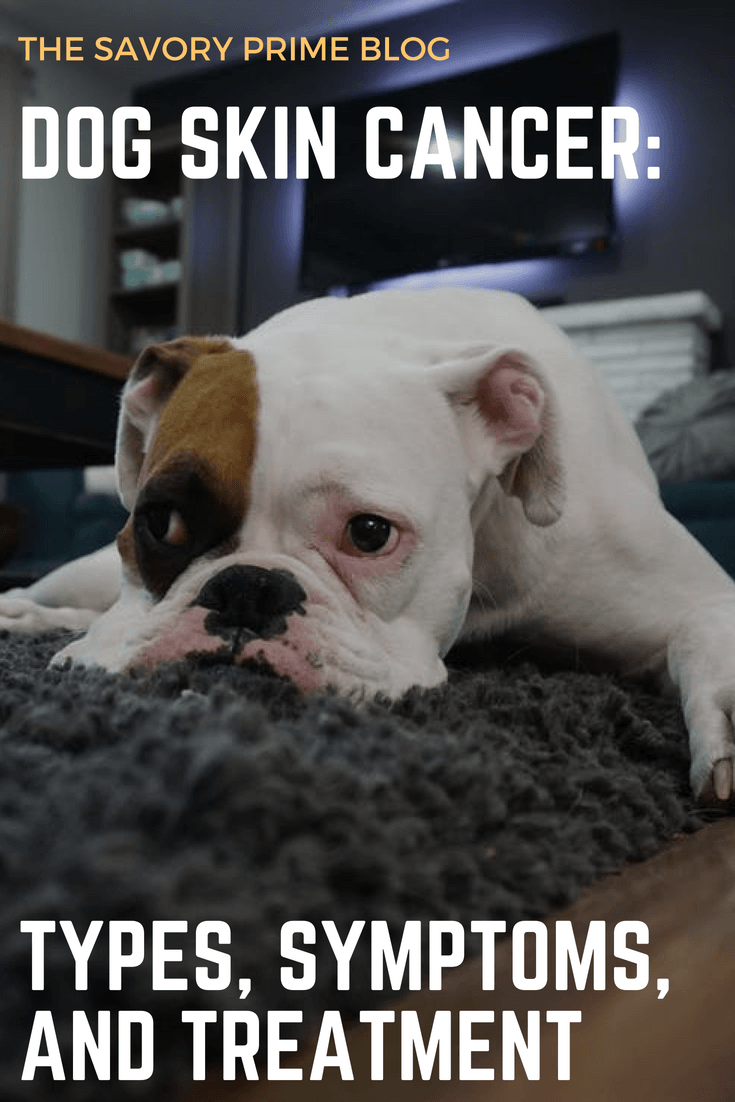The word “cancer” instills fear into the heart of every dog owner, but not all growths are cancerous. The most common growth found in dogs are lipomas, which are fat cells. Also commonly found on dogs are sebaceous cysts, which can become cancerous. If your veterinarian has diagnosed your dog with skin cancer, or if you are concerned that your dog might have a cancerous skin tumor or lump, it is understandable to feel worried and fearful.
Your veterinarian is your best resource to help you with any questions you may have about your dog’s health and skin issues. However, here is some information you need to know about skin cancer in dogs to help you understand your dog’s possible condition.
Can Dogs Get Skin Cancer?
Dogs can get skin cancer, just like we can. In fact, skin tumors are the most commonly diagnosed type of tumor in dogs. This is partly because skin tumors are easier to see with the naked eye than other types of tumors, and partly because the skin is exposed to more of the environmental factors that can cause tumors, such as chemicals, viruses, and solar radiation, then your dog’s internal structures. Luckily, this also means that you and your veterinarian have a better chance of catching your dog’s cancer before it progresses past available treatment options.
Causes of Skin Cancer in Dogs
Skin cancer can have a variety of causes. Just like with people, genetics play a large role in which dogs are more likely to get skin cancer. In fact, it is believed that genetics is the number one factor in the risk of a dog getting skin cancer. Triggers that may lead to a dog developing skin cancer include too much exposure to the sun, chemicals in the environment, hormonal abnormalities and certain types of viruses.
Types of Skin Cancer in Dogs
There are several different types of skin cancer in dogs, just like there are several different layers of the skin. Each layer and skin component can develop distinct tumors, some of which may turn out to be cancerous.
Some of the more common types of skin cancer in dogs are:
- Malignant melanoma
- Mast cell tumors
- Squamous cell carcinoma
- Histiocytic cell tumors
- Fibrosarcoma
Malignant Melanoma
Melanomas can be either malignant or benign. These tumors are often dark-pigmented or can lack pigment. While benign melanomas are more common, malignant melanomas are a serious concern, as they grow quickly and have a high risk of metastasis (spreading to other organs).
Malignant melanomas are most commonly found on the lips, mouth, and nail beds. According to some researchers, the head, neck and scrotum areas are also moderately predisposed to skin cancer. Certain breeds, for example, Miniature and Standard Schnauzers and Scottish Terriers, are at an increased risk, and males appear to be affected more than females.
Malignant melanomas look like raised lumps, often ulcerated, and can also look like gray or pink lumps in the mouth. Nail bed malignant melanomas, on the other hand, show up as toe swelling and possibly even loss of the toenail itself and destruction of underlying bone. Nail bed and footbed tumors often develop a secondary infection, leading to a misdiagnosis. These types of tumors usually metastasize to other parts of the body, decreasing the chances for a good outcome.
Mast Cell Tumors
Mast cell tumors are the most common types of skin cancer tumors. Mast cells release histamine, which is the chemical that causes some of the symptoms of allergic reactions in dogs, like irritation and itching. Mast cell tumors are cancer of these cells, and they can grow anywhere on your dog’s skin, as well as in internal organs. The most common sites for mast cell tumors are the limbs, lower abdomen, and chest. About ¬º of mast cell tumors are found on dogs’ limbs.
Boxers, Pugs, Rhodesian Ridgebacks, Boston Terriers and older mixed breed dogs seem particularly susceptible to mast cell tumors, which most commonly affect dogs ages 8-to-10 years old. This cancer can be difficult to deal with, and your dog could have symptoms associated with toxins released from malignant mast cells, such as stomach ulcers, resulting from histamine release.
Squamous Cell Carcinoma
Skin squamous cell carcinoma is the most commonly diagnosed carcinoma of the skin, and primarily affects older dogs, especially Bloodhounds, Basset Hounds, and Standard Poodles. These tumors typically show up on the head, lower legs, rear, and abdomen, and appear as raised patches or lumps that are firm to the touch.
Exposure to the sun can be a cause of squamous cell carcinoma, but according to the National Canine Cancer Foundation, “In dogs, the theory of exposure to the sun is less obvious. It is believed that there may be some association with papillomavirus.”
These tumors usually appear on your dog’s abdomen, which is the area least protected from the sun by hair.
Histiocytic Cell Tumors
Histiocytic cells are a type of skin cell. When these cells proliferate into tumors, they are classified as histiocytic cell tumors.
These types of tumors are relatively common and typically affect dogs under 3 ¬Ω years old, especially Scottish Terriers, Bulldogs, Greyhounds, Boxers, Boston Terriers, and Chinese Shar-Pei.
There are three types of histiocytic cell tumors: histiocytomas, which are the most common; systemic histiocytosis, which mainly affects Bernese Mountain Dogs; and malignant histiocytosis, which also mainly affects Bernese Mountain Dogs and first shows up in the internal organs.
Fibrosarcoma
Fibrosarcoma and spindle cell tumors originate in the connective tissues of the skin and beneath the skin. These tumors can have a varied appearance, and while they are typically slow growing, they do tend to recur after surgical removal. Luckily, this type of tumor rarely metastasizes.
Fibrosarcoma usually affects dogs when they are middle-aged or older, with an average age of 10 years. Sometimes, an aggressive type of fibrosarcoma can affect young dogs. Your veterinarian will send off a sample of the tumor to a pathologist to determine whether or not the tumor is a low- or high-grade tumor, a classification that refers to the rate of cell division. This will help them give your dog an accurate prognosis and determine the best course of treatment.
This type of tumor is often found on the limbs. In addition to invading nearby structures, sometimes impeding their function, the tumors can also bleed, ulcerate, and become infected.
Symptoms of Skin Cancer in Dogs
The symptoms of skin cancer vary depending on the cancer, but in general, the best thing you can do to catch skin cancer early is to keep an eye on any strange lumps or bumps on your dog’s body, especially as he ages.
Not all skin tumors are cancerous, and some, like skin tags, are usually benign sebaceous cysts or lipomas. However, if you discover an unusual lump or area of discoloration, play it safe and contact your veterinarian. Changes in the size, shape, color or ulceration of any growth or lump are also a cause for concern.
Diagnosing Skin Cancer in Dogs
Dog skin cancer is diagnosed by examining the cells of the skin tumor or lesion. Your veterinarian may perform a procedure called a fine needle aspiration, which takes a small sample of cells, or a biopsy, which removes a small portion of the tumor tissue or lesion by surgical incision. These samples are usually sent away to pathology for evaluation in order to obtain an accurate diagnosis.
Skin Cancer Treatment Options
A diagnosis of cancer for your dog is scary. Many types of skin cancer are treatable if caught early on, but it is understandable to feel worried.
Your dog’s prognosis and treatment options will depend on a few factors, including the type of tumor, the location of the tumor, and the stage of cancer.
Some skin tumors can be removed surgically to great effect. Others may require additional steps, such as radiation or chemotherapy.
Some types of cancer, for example, malignant melanomas, are resistant to radiation therapy, while others, such as mast cell tumors, are more sensitive. Your veterinarian may refer you to a veterinarian oncologist when you have a cancer diagnosis. Veterinary oncologists have advanced training in cancer treatment.
Preventing Skin Cancer in Dogs
Some types of diseases are preventable, while others are not. As in humans, many cancers are the result of a genetic predisposition. In other cases, cancer is the result of a variety of factors coming together in an unlucky configuration, but there are a few things you can do to lower your dog’s risk.
The risk factor most in your control is exposure to sunlight. If you have a light-skinned, short-haired dog breed, limiting your dog’s exposure to direct sunlight, especially during the peak daylight hours, may help lower his risk of skin cancer.
The most important thing you can do to help your dog avoid skin cancer, however, is to familiarize yourself with all your dog’s lumps, bumps, and rashes, perhaps during your daily grooming routine, and consult your veterinarian if you notice anything suspicious.
Recent Pet Posts
Blog Categories
Product categories
- Accessories (7)
- Chicken & Veggie Wraps (8)
- Grillers Jerky Tenders (4)
- Jerky Treats (10)
- Made in the USA (9)
- Non-Rawhide Treats (28)
- Beggar Bone (11)
- Bully Sticks (4)
- Butcher Bone (4)
- Cod Skin Fish Treats (3)
- Pork Skin Twists (2)
- Pressed Rawhide Bones & Rolls (16)
- Bones & Rolls (6)
- Pressed Rawhide Bulk (6)
- Twist Sticks (4)
- Savory Munchies (13)
- Supreme Bones & Rolls (48)
- American Rawhide Bulk (16)
- Rawhide Bones (14)
- Rawhide Chips (6)
- Rawhide Rolls & Sticks (12)
- Uncategorized (8)





1 Comment. Leave new
Very informative read!!